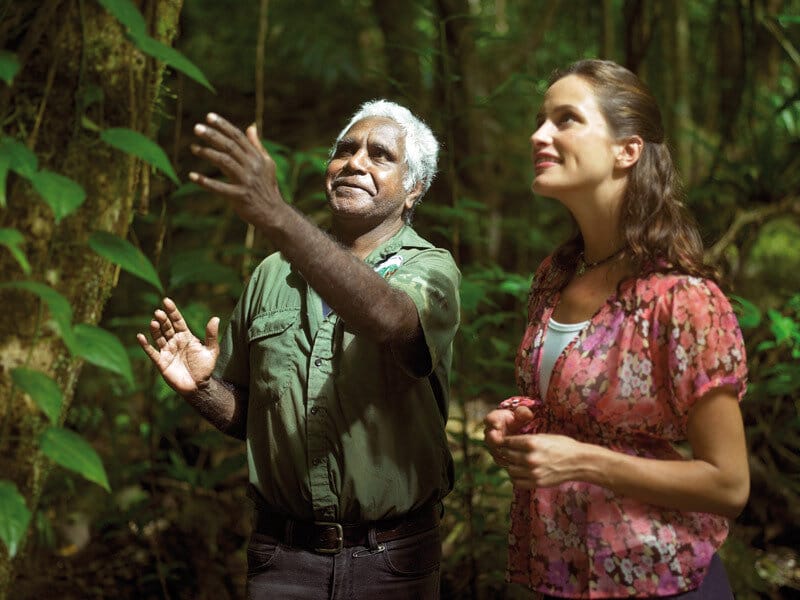Guurbi is a time, place, a space, a personal sanctuary or dwelling place made sacred by Yimbal, the rainbow serpent, a place for reflection and for the quiet time spent before bora when important decisions were made.
Because guurubi is sacred it must not be entered, accessed or used without permission or without acknowledgement of Aboriginal lore or law.
These tours are an invitation from Willie to join him at his Guurrbi- his very own personal place
These magical award-winning Aboriginal tours with Nugal-warra Elder, Wilfred (Willie) Gordon, are now listed as One of Australia’s Ultimate Must-Do Experiences.Willie, the traditional story-keeper of the Nugal-warra clan, takes guests to his ancestral rock art sites at Wangaar-Wuri, high in the hills above
Hope Vale, outside Cooktown. Here he shares the stories behind the art, and explains how the cave paintings speak of the essence of life and the lores of his people.With his great smile and infectious laugh, Willie gives an amazing insight into Aboriginal culture and society, and shows how we all have a spiritual place, wherever we come from.
The Aboriginal rock art sites of the Nugal-warra are about 40 minutes drive from Cooktown, travelling along the Endeavour Valley. It’s a very beautiful area surrounded by hills – six of which mark the boundaries of the Nugal lands. The road is partly unsealed, but passable except in very bad weather.
We then leave the road and travel on a small track, climbing through woodlands to the area known as Wangaar-Wuri, which is the location of the rock art sites. This is a stunning area with giant rocks, sandstone escarpments and spectacular views. It’s a beautifully peaceful place, and we walk on tracks which have been used by the Nugal people for centuries.
Rainbow Serpent Tour
Your Rainbow Serpent Tour begins from your Cooktown accommodation where you are collected in air-conditioned transport and driven to the outskirts of Hope Vale Aboriginal Community – a journey of about 40 minutes. On the way you will learn some of the Aboriginal history and stories about the landscape you are passing through.
Once at the entrance to the sites you leave the vehicle and continue on foot in the company of Nugal-warra Elder and story-keeper Willie Gordon. Willie takes you through a dramatic landscape to six rock art sites, including the Rainbow Serpent Cave and an ancestral Birth Site where his father and grandfather were born. Here he explains the significance of the paintings and the stories behind the art, giving his guests a unique insight into Aboriginal philosophy and spirituality. And as you walk the ancient tracks used by the Nugal people for centuries, Willie shares some of his vast knowledge of the land you’re in: its bush tucker and medicines, creatures which forecast the weather, flowers which give messages, leaves which make soap, how to interpret snake tracks or give a little lizard a drink….No two tours are ever the same, but whatever happens you’ll be enchanted and enthralled.
The tour includes an estimated 30-minute bush walk. There is a short climb to two of the sites, but generally the terrain is easy. The tour is not suitable for those with limited mobility or respiratory problems.
What to bring
Sunscreen and hat. Closed footwear MUST be worn! Cameras are welcome. Water is provided.
Children under 4 years
We recommend that families with children under 4 years take the self-drive tour option, as our vehicles are not equipped to carry anchored baby capsules and child seats.
Staying in Helenvale?
As tour timings make it impossible for us to pick up customers from Mungumby Lodge and the Lion’s Den in Helenvale, clients are collected from our Cooktown Booking Office at the Cooktown Motel Pam’s Place, corner of Boundary & Charlotte Streets (overlooking the roundabout) at 7.45 am. You should allow about 35 minutes for the journey from Helenvale into Cooktown.
Wanthaal-bi ngayu – We look forward to seeing you!
Great Emu Tour
Your Great Emu Tour begins at your Cooktown accommodation where you will be collected in air-conditioned transport, and driven to the outskirts of Hope Vale Aboriginal Community – a journey of about 40 minutes. On the way you will learn some of the Aboriginal history and stories about the landscape you are passing through.
Once at the entrance to the sites you leave the vehicle and continue on foot in the company of Nugal-warra Elder and story-keeper Willie Gordon. Willie takes you to three rock art sites, including the Rainbow Serpent and Great Emu Caves. Here he explains the significance of the paintings and the stories behind the art, giving you a unique insight into Aboriginal society and spirituality. The tour is suitable for most ages: there is a short climb to one of the sites, but overall very little walking is involved
What to bring
Sunscreen and hat. Closed footwear MUST be worn! Cameras are welcome. Water is provided.
Children under 4 years
We recommend that families with children under 4 years take the self-drive tour option, as our vehicles are not equipped to carry anchored baby capsules and child seats.
Staying in Helenvale?
As tour timings make it impossible for us to pick up customers from Mungumby Lodge and the Lion’s Den in Helenvale, clients are collected from our Cooktown Booking Office at the Cooktown Motel Pam’s Place, corner of Boundary & Charlotte Streets (overlooking the roundabout) at 1.45 pm. You should allow about 35 minutes for the journey from Helenvale into Cooktown.
Wanthaal-bi ngayu – We look forward to seeing you!
A big ‘thank you’ to Fran Golden for her article ‘Life Lessons’ in The Miami Herald – and for including us on her dream vacation bucket list!
Here’s a snippet…
“Wilfred Gordon picks us up in an air-conditioned van at our hotel in remote Cooktown, in far northeast Australia… A Nugal-warra elder and story-keeper, Gordon is taking my companion and me out into the countryside to his clan’s private Guurrbi — sacred place — to see cave art drawn by his ancestors.
A walkabout in the bush with an Aborigine was high on my list of things to do in Australia. But it’s immediately clear with Gordon we have not signed up for some touristy indigenous offering. He informs us the lessons of the day will be in what he calls “the two s’s,” spirituality and survival….”
When people use the word ‘walkabout’ today, it conjures up an aimless wandering. But for Guugu Yimithirr people it was a survival strategy, strictly governed by local lore, and its direction determined by the location of food and resources. The land is fragile so the Bama of this region moved around with the seasons, always respecting the lores governing hunting and gathering in order to protect the environment which looked after them.
During the winter months we would move down to the coast, leaving the wallabies and kangaroos to have their young undisturbed. At the coast the fruits, nuts and berries were ready to eat earlier than those inland, so we would have a plentiful supply of buthurr from the zamia palm, buthu from the paperbarks, and wunha plums from the nonda tree. Whilst we were here we would also collect gaarruul (seaweed), muthurr (witchetty grubs), and dig up the yams and collect their seeds for replanting.
We knew when it was time to go to the coast by the presence of certain birds and flowers; signs which we still use today. When the wattle is in flower we know to go and collect oysters and mussels, as this is the time they’re hibernating and at their plumpest. And a special yellow flower tells us when the blue-tailed mullet is travelling to its spawning place and is at its fattest and most nutritious.
The beautiful red flower of nanggaarr-buurra, the kapok, signals that bush hens are beginning to lay their eggs, together with all the other egg-laying species. And the arrival of wabul, the Torres Strait pigeon, tells us that the migrating birds from Papua New Guinea are now nesting on the outer islands and coming in to feed, and that mulun, the quondong fruit, will be ready to eat.
This is also the time to catch stingrays and a small, yellow, black-finned shark, whose livers take on a pinkish hue to show that they’re full of oil. The fish oil is really important for a healthy diet, and helped keep us physically fit. The goanna is another animal from which we extracted the oil. Their fat is thought to be particularly good for preventing arthritis, and is best extracted before they hibernate during the wet season.
All through the year nature signals to us, so we know when the barramundi are plump, when river prawns and freshwater catfish are at their best, or sea urchins and native honey ready to be collected.
Importantly, bush lore also dictates what we can not hunt, although sadly, today, this is often ignored.

